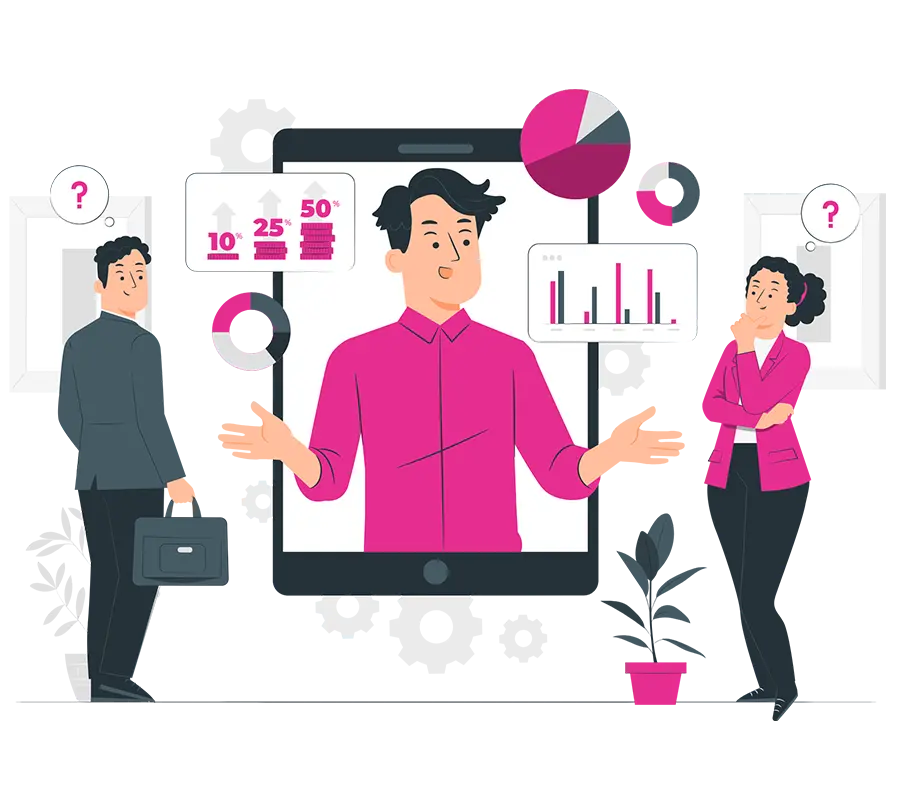Is profit the only consideration in doing business? C’mon, you must realize that the old way of doing business doesn’t work anymore.
Customers need to believe that the companies they support are not just looking for fast money. They need to witness that you too are struggling for a greener world and a fairer society. This is the power of business sustainability strategies.
Sustainability implementation is not rocket science. This guide breaks down sustainability strategies into clear steps, offering strategies and examples to help you make a real difference – starting today.
Table of Contents
ToggleWhat are business sustainability strategies?
This is not just planting some trees! (Although planting some trees is awesome too!). It is finding that middle ground where your firm prospers without harming the planet and its people.
Imagine less pollution, improved working conditions, and being direct contributors to your community. This involves:
- Environmental Protection: Waste reduction, carbon footprint, renewables, and resource usage such as water.
- Ethical Business Practices: Fairtrade, a safe and diverse workplace, transparency, and accountability.
- Positive Social Impact: Community investing, local causes support, social issues organizations partnership, employee well-being.
List of 13 Business Sustainability Strategies
| Area of Focus | Strategy |
| Energy | Transition to renewables (solar, wind, etc.) |
| Optimize energy efficiency (upgrades, audits) | |
| Waste | Implement recycling & composting |
| Reduce single-use items | |
| Design for circularity (repair, upcycling) | |
| Materials | Use recycled & eco-friendly materials |
| Minimize packaging | |
| Supply Chain | Partner with sustainable suppliers |
| Optimize transportation (efficiency, local sourcing) | |
| Community | Support local initiatives (donations, sponsorships) |
| Offer employee volunteer programs | |
| Employee Well-being | Prioritize fair wages & benefits |
| Foster a culture of inclusion |
Why make business sustainability strategies a Priority?
64% of European businesses have an Environmental Policy. Building a sustainable business is not just a duty; it makes excellent business sense:
- Customer Priorities: More and more people want to buy from companies that help the planet, not hurt it.
- Save money: Green is when you use less energy and produce less trash – that saves you money!
- Happy workers: Young people particularly wish to work for organizations that do positive things.
- Stay safe: Factors such as insane weather or changing laws can impact your business. Green will help you to get set.
- New ideas: The attempt to solve echo problems can result in great innovative ways of doing things for your business. You may like to explore sustainable business ideas to ensure a better future.
Developing Your Business Sustainability Strategies: A Step-by-Step Guide
Let’s break down the practical steps to transform your business into a force for good:
1. Define Your “Why” and Your Goals
Why does being a green business matter to you? What kinda good stuff do you want your company to do?
Example: Maybe you make shoes, and you wanna cut pollution in half in 5 years and only use recycled stuff to make them.
2. Understand Your Current Impact
- Where’s your business leaving the biggest mark on the planet (good or bad)?
- Look at how you make stuff, where you get supplies, and what kinda trash you make.
Tools: There are special calculators online to figure out your company’s effect on the planet.
3. Get Everyone Involved
- This ain’t a solo mission! Ask your employees, customers, and even neighbors for ideas.
- Make a “Green Team” in your company to be in charge of all this awesome planet-helping stuff.
4. Prioritize and Set Targets
- Figure out where you can make the BIGGEST changes.
- Set some goals: Aim high, be specific, and make sure you can measure if you’re hitting those goals.
5. Take Action: Examples & Strategies
| Area | Potential Actions |
| Energy | Switch to renewable energy, install energy-efficient systems, educate employees |
| Waste | Implement a robust recycling program, compost, and go paperless |
| Water | Install low-flow devices, fix leaks, reuse water |
| Materials | Use recycled or eco-friendly materials, minimize packaging |
| Supply Chain | Work with ethical suppliers, optimize transportation routes |
| Community | Donate to local charities, volunteer programs, and sponsor events supporting your cause |
6. It’s About Innovation
Sustainable business strategies demand looking for new ways to do things better.
- Invest in the future: Never fear to try out different materials, improved methods of making things, and even brand-new ways of doing business. This is action!
- Teamwork makes the dream work: Allies with other enterprises or research groups to come up with ideas and pool your strengths. In matters of innovation, one plus one makes a lot more than two.
- The circle of (business) life: Brainstorm approaches to keeping products and materials in use for the longest time. Do you repair or recycle old products? Can you give a product as a service rather than always selling something completely new?
7. Transparency & Reporting
Communicate openly about your goals and progress, including the challenges you face.
- Keep it real: Be honest with your consumers about how you are striving to be more sustainable, and do not try to mask the difficulties. They’ll respect your honesty.
- Share your journey: Utilize reports and updates to communicate to all what progress your efforts are making. Follow-up tracking is inspiring!
8. Embrace the Circular Economy
The Circular Economy aims to keep resources in use as long as possible, minimizing waste.
- Built to last: Design things that people will use for a long time and are easy to repair when they get broken.
- What goes around, comes around: Provide customers with means to return the products when they are through with them. You may be in a position to reuse, resell, or recycle the parts.
9. People Matter: The Social Sustainability Pillar
Sustainable businesses care about their people and the communities they serve.
- Treat employees right: A sustainable business is aware that taking care of its people is vital. It also includes fair pay, excellent benefits, and a work environment that is safe and supportive.
- Everyone deserves a seat at the table: Try hard to turn your company into a place where everyone is welcome and appreciated. Request your suppliers to maintain the same standards.
- A healthy team is a happy team: Support your employees to become more healthy, both physically and mentally, and to help them grow within the company.
- Give back to your community: Discover how you can add value in the area where you trade. This might mean teaming up with local charities, helping out in schools, or giving your time to a good cause.
10. Stay Informed, Adapt & Evolve
- Stay on top of things: The sustainability domain is advancing rapidly! Observe new ideas, changes in the laws, and demands of customers to be prepared to adjust.
- Always strive to be better: Always keep on searching for ways of up-gradation. The road to a truly sustainable business is never-ending.
Tackling the Challenges of Sustainable Business
Okay, a sustainable business is fabulous for the planet and the future legacy of your company. But let’s be real – there are some hurdles to clear
- The Money Thing: At times to be green means spending a little extra initially (for example, switching to solar power). The secret is long-term thinking – all these odd solar panels will eventually save you a fortune!
- Breaking Old Habits: Change is a difficult thing to implement across the entire organization. Clearly explaining why the change is important, rewarding wins along the way, and even some fun incentives can make a big difference.
- The Supply Chain Shuffle: Ensuring the sustainability of your whole supply chain is a large task. You will require strong supplier partnerships and an unambiguous understanding of “sustainable” in reality.
- Avoiding the “Greenwashing” Trap: Practice what you preach – go green! Let everything you do be open, and support your statements with facts.
Strategies to Address Challenges
- Start Small & Win Big: Start with achievable and measurable goals then share these wins with your team to spread passion and ownership among them.
- Collaborate for Impact: Collaborate with other businesses, NGOs, or experts who can contribute more and widen your reach.
- Long-Term Thinking: Sustainable investments may exhibit delayed returns, but they usually offer great returns and competitive leads in the long run.
Bright Future of Sustainable Business
Companies that become serious about sustainability are not only doing what is right, but they are also positioning themselves for success. Here’s why:
- Your reputation matters: People need to patronize companies, which are not only concerned about making profits but also genuinely care. Walking the walk on sustainability develops trust – customers demand your products and investors want your shares.
- Weathering the storms: The reality is that sometimes climate change and social issues can be somewhat tricky. Sustainable businesses are more capable of coping with such disruptions and emerge stronger.
- The idea factory: Sustainable thinking makes you find other and better ways of doing something. This type of innovation makes your business different and it helps solve some of the biggest problems of the world.
Real-World Examples: Companies Leading the Way in Sustainability
Inspiration often sparks new ideas. Let’s look at companies of various sizes successfully integrating sustainability into their core business:
Patagonia (Outdoor Clothing & Gear): Patagonia’s mission is deeply rooted in environmentalism. They:
- Recycles a lot and uses eco-friendly materials.
- They want you to repair your items, rather than throw them away.
- Donate 1% of sales to support the planet.
- Supervocal in the issue of saving nature.
IKEA (Furniture & Home Goods): IKEA has ambitious sustainability goals:
- To have a zero impact on the planet by 2030.
- Changing to renewable energy everywhere.
- Make use of a whole lot of recycled materials in their products and make them easy to dismantle.
- They also allow you to sell them your old IKEA furniture!
Unilever (Consumer Goods Giant): Unilever, the owner of brands like Dove and Ben & Jerry’s, has its own Sustainable Living Plan:
- Commit to reducing the environmental footprint of their products by 50%.
- Mindful of where their ingredients come from, benefiting farmers.
- All about equality and justice for all.
Tesla (Electric Vehicles): Tesla’s core disruption is accelerating the shift towards sustainable transportation:
- They are, all in all, leaving gas-guzzlers for good.
- Put a ton of money into clean energy and battery tech.
- Constantly striving to make their cars and plants more environmentally friendly.
The Green Grocer: Local Business near my House
A neighborhood grocery store called The Green Grocer. They understand that even small businesses can make a big difference. Here’s how they focus on sustainability:
- Fighting Food Waste: They donate unsold food to shelters and compost any unusable scraps.
- Supporting Local: They buy fruits and vegetables from nearby farms, reducing transportation pollution and ensuring freshness.
- Bring Your Bag: Customers get a small discount for bringing reusable bags, cutting down on plastic use.
Key Takeaways from These Examples
- Being green is different for everyone: The things companies do to help the planet depend on what they make and sell.
- Aiming high makes you try harder: Big goals make companies create innovative ways to achieve them.
- Don’t hide the hard stuff: When corporations are transparent about what is hard and how they are making it better, people trust them more.
- Everyone can help: But it is not only big companies! Local, small businesses too can create a better world.
Action Plan: Where to Start and How to Progress
Let’s assume that you have any of the following businesses:
Industry: Manufacturing
Scenario: Imagine a company that makes furniture. They find out that the company they buy wood from is cutting down too many trees and harming the forest
Immediate Steps:
- Stop the Bad: End orders with that supplier ASAP.
- Tell the Truth: Be transparent with employees and customers. Your honesty will pay off.
- Go Sustainable Hunting: Look for suppliers with those sweet, sweet certifications proving they care about forests. Think “FSC” labels.
- Explore Cool Alternatives: Recycled wood? Bamboo? Time to get creative!
- Shout it Out: Update your website, and let folks on social media know how much you care about responsible sourcing.
Partner with us, and get your website ready to show your sustainable business practices!
- Labels on Furniture: Add a small tag explaining your wood comes from responsible sources.
- Partner with an Organization: Work with a group that protects forests to show you’re serious.
Industry: Retail (Clothing)
Scenario: A popular boutique discovers rising customer concern about the environmental and social impact of the fast fashion industry. Customers want to know where the clothes are made and under what conditions.
Assessing Suppliers
- Questionnaire: Create a checklist asking suppliers about their materials, production processes, worker conditions, and environmental policies.
- Certification Standards: Look for suppliers with certifications like Fairtrade, GOTS (for organics), or B-Corp (for overall ethical practices).
- Transparency: Encourage suppliers to be open about their practices and even share photos or videos of their factories.
Sourcing Alternatives
- Local Focus: Seek out small-scale designers or makers in your area who prioritize sustainability and craft their items locally.
- Eco-Friendly Materials: Look for brands using organic cotton, recycled fabrics, plant-based dyes, and natural fibers.
- Search Platforms: Online marketplaces like Etsy or dedicated sustainable fashion platforms can connect you with ethical brands.
Take-Back Program:
- In-Store Collection: Dedicate a space for customers to drop off used clothing from any brand.
- Partner Up: Team up with textile recycling organizations or secondhand resellers that can process the collected clothing responsibly.
- Incentivize Participation: Offer customers discounts or reward points for participating in the take-back program.
Communicating the Shift
- Website & In-Store: Create a dedicated “Sustainability” page highlighting your commitment, new ethical brands, and initiatives like the take-back program.
- Social Media: Share engaging stories about the makers behind your clothes, the benefits of eco-materials, and how to give garments a longer life.
- Visuals: Use photos, videos, and infographics to make your sustainability story easy to understand and share.
Quick Win: Packaging
- Eliminate Plastic: Switch to reusable cloth bags or recycled paper bags.
- Recycled Shipping: Choose boxes made from post-consumer recycled content.
- Compostable: Explore compostable mailers or packing peanuts made from cornstarch for a zero-waste shipping option.
Industry: Tech
Scenario: A growing software company wants to reduce its carbon footprint. Its major energy consumption comes from its data centers.
Questions
- Could the company switch to a green energy provider or invest in on-site renewable energy generation (like solar)?
- Are there ways to optimize server usage and data storage to increase energy efficiency?
- Does the company offer remote work options to reduce employee transportation emissions?
- How could they track and transparently report their progress toward carbon reduction goals?
Quick Win: Implement a device and electronics recycling program. Partner with a certified e-waste recycler to ensure proper disposal and prevent harmful materials from entering landfills.
Benefits of Sustainability in Business
Becoming sustainable doesn’t happen overnight, it takes time and work. But don’t panic, it’s all worth it! Here’s why:
- You’ll do the right thing: Your business will be based on fairness, honesty, and protection of the environment.
- Your business will be stronger: It is scalable for future changes and cost-effective in the long run.
- You’ll make a difference: By adopting sustainability you’ll give the planet a new – a better – home to every living being, in the present and the future.
FAQs- Business Sustainability Strategies
What is a business sustainability strategy?
A business sustainability strategy is a plan that gets an organization to act in a way that stays friendly to the environment, treats people fairly, and makes a better future for all.
What are the 5 steps to create a more sustainable business strategy?
- Understand Your Impact
- Set Goals
- Get Everyone Involved
- Take Action
- Measure and Share Your Progress
What are the three sustainability strategies?
- Environment: Defend natural resources, limit pollution, and reduce waste.
- Social: Give employees and communities a fair shake; promote diversity and inclusion
- Economy: Profit mixed with the long-term impact on the environment.
Wrapping Up
Turning your business into a brand that is good for the planet and its people is not just a good thing, it is the only thing in business of the future. Consider business sustainability strategies as your hidden advantage! It will make your business prosperous and bring progress to the world at the same time. Today we begin and tomorrow we build a future we can be proud of!





